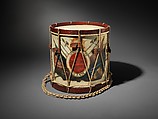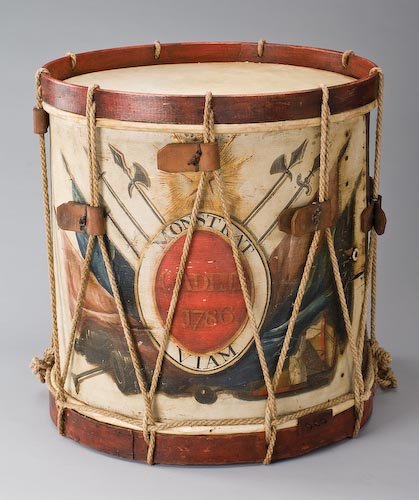Side drum
Henry H. Prentiss American
Not on view
The side drum was associated with the military, especially as a signal instrument for infantry troops, from at least the sixteenth century through the end of the nineteenth century. This large drum is eighteen inches in height with a seventeen inch diameter. The shell is made of a thin sheet of wood bent into a cylinder and then glued together and reinforced with brass tacks that are visible from the exterior of the drum. This example utilizes the traditional rope tensioning system, with a single length of rope running between the wood counter hoops and leather tugs used to tighten or loosen the tension on the heads. A set of gut cords are stretched across the bottom head and create a buzzing sound when the top (batter) head is hit.
The drum bears a large painted decoration on a white field. The composition has at its center a large red oval with the words: CADET / 1786. Around the central oval is a white ring with the Latin motto: Monstrat Viam. Above this sits a five pointed star. Taken together, these symbols and mottos attributed the drum as having been made (or decorated) for a member of the First Corp of Cadets in Boston, Massachusetts. That military unit was founded in 1786 and had a storied history. This drum, likely made in the 1830s or 40s, may have been built for an anniversary or other important event marked by the corps. Around this central decoration is painted an assemblage of military equipment including flags, cannon, halberds, and drums. This decoration is rather unusual on American drums, which traditionally feature an American flag or eagle. The grouping of military accoutrements is more common on European examples. Another Boston drum, also by Prentiss, located at the Boston Museum of Fine Arts has a similar composition and was signed by the artist Charles Hubbard.
Henry Prentiss was born Roxbury, Massachusetts in 1801 and died in Boston in 1860. He worked first as an umbrella maker, listed as active in that business as late as 1829. By the 1830s he was selling musical items and perhaps building woodwind instruments and drums actively throuh the 1840s.
Due to rights restrictions, this image cannot be enlarged, viewed at full screen, or downloaded.
This artwork is meant to be viewed from right to left. Scroll left to view more.



